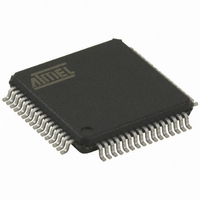AT89C5122D-RDRUM Atmel, AT89C5122D-RDRUM Datasheet - Page 149

AT89C5122D-RDRUM
Manufacturer Part Number
AT89C5122D-RDRUM
Description
IC 8051 MCU 32K CRAM USB 64-VQFP
Manufacturer
Atmel
Series
89Cr
Datasheet
1.AT89C5122D-PSTUM.pdf
(208 pages)
Specifications of AT89C5122D-RDRUM
Core Processor
8051
Core Size
8-Bit
Speed
48MHz
Connectivity
SmartCard, SPI, UART/USART, USB
Peripherals
LED, POR, WDT
Number Of I /o
46
Program Memory Size
32KB (32K x 8)
Program Memory Type
FLASH
Ram Size
768 x 8
Voltage - Supply (vcc/vdd)
3 V ~ 5.5 V
Oscillator Type
Internal
Operating Temperature
-40°C ~ 85°C
Package / Case
64-TQFP, 64-VQFP
For Use With
AT89OCD-01 - USB EMULATOR FOR AT8XC51 MCUAT89STK-10 - KIT EVAL APPL MASS STORAGEAT89STK-03 - KIT STARTER FOR MCU AT8XC5122/23
Lead Free Status / RoHS Status
Lead free / RoHS Compliant
Eeprom Size
-
Data Converters
-
Other names
AT89C5122D-RDRUMTR
Available stocks
Company
Part Number
Manufacturer
Quantity
Price
- Current page: 149 of 208
- Download datasheet (3Mb)
Mode 0 (13-bit Timer)
Mode 1 (16-bit Timer)
Mode 2 (8-bit Timer with Auto-
Reload)
Mode 3 (Halt)
4202F–SCR–07/2008
•
•
Mode 0 configures Timer 1 as a 13-bit Timer, which is set up as an 8-bit Timer (TH1 reg-
ister) with a modulo-32 prescaler implemented with the lower 5 bits of the TL1 register
(see Figure 89). The upper 3 bits of TL1 register are ignored. Prescaler overflow incre-
ments the TH1 register.
Mode 1 configures Timer 1 as a 16-bit Timer with TH1 and TL1 registers connected in
cascade (see Figure 91). The selected input increments the TL1 register.
Mode 2 configures Timer 1 as an 8-bit Timer (TL1 register) with automatic reload from
the TH1 register on overflow (see Figure 93). TL1 overflow sets the TF1 flag in the
TCON register and reloads TL1 with the contents of TH1, which is preset by the soft-
ware. The reload leaves TH1 unchanged.
Placing Timer 1 in mode 3 causes it to halt and hold its count. This can be used to halt
Timer 1 when the TR1 run control bit is not available i.e. when Timer 0 is in mode 3.
When Timer 0 is in mode 3, it uses Timer 1’s overflow flag (TF1) and run control bit
(TR1). For this situation, use Timer 1 only for applications that do not require an
interrupt (such as a Baud Rate Generator for the Serial Port) and switch Timer 1 in
and out of mode 3 to turn it off and on.
It is important to stop the Timer/Counter before changing modes.
AT83R5122, AT8xC5122/23
149
Related parts for AT89C5122D-RDRUM
Image
Part Number
Description
Manufacturer
Datasheet
Request
R

Part Number:
Description:
IC 8051 MCU W/SMART CARD 64VQFP
Manufacturer:
Atmel
Datasheet:

Part Number:
Description:
IC 8051 MCU FLASH 32K 64QFN
Manufacturer:
Atmel
Datasheet:

Part Number:
Description:
IC 8051 MCU FLASH 32K 64VQFP
Manufacturer:
Atmel
Datasheet:

Part Number:
Description:
IC MCU 80C51 W/SMART CARD 64VQFP
Manufacturer:
Atmel
Datasheet:

Part Number:
Description:
IC 8051 MCU FLASH 32K 28PLCC
Manufacturer:
Atmel
Datasheet:

Part Number:
Description:
MICROCONTROLLER WITH USB AND SMART CARD READER INTERFACES
Manufacturer:
ATMEL [ATMEL Corporation]
Datasheet:

Part Number:
Description:
KIT STARTER FOR MCU AT8XC5122/23
Manufacturer:
Atmel
Datasheet:

Part Number:
Description:
IC MICRO CTRL 24MHZ 44TQFP
Manufacturer:
Atmel
Datasheet:

Part Number:
Description:
IC MICRO CTRL 24MHZ 44PLCC
Manufacturer:
Atmel
Datasheet:

Part Number:
Description:
IC MICRO CTRL 24MHZ 44PLCC
Manufacturer:
Atmel
Datasheet:

Part Number:
Description:
IC MICRO CTRL 24MHZ 40DIP
Manufacturer:
Atmel
Datasheet:













